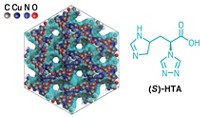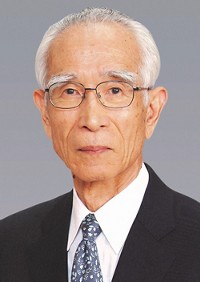Advertisement
Grab your lab coat. Let's get started
Welcome!
Welcome!
Create an account below to get 6 C&EN articles per month, receive newsletters and more - all free.
It seems this is your first time logging in online. Please enter the following information to continue.
As an ACS member you automatically get access to this site. All we need is few more details to create your reading experience.
Not you? Sign in with a different account.
Not you? Sign in with a different account.
ERROR 1
ERROR 1
ERROR 2
ERROR 2
ERROR 2
ERROR 2
ERROR 2
Password and Confirm password must match.
If you have an ACS member number, please enter it here so we can link this account to your membership. (optional)
ERROR 2
ACS values your privacy. By submitting your information, you are gaining access to C&EN and subscribing to our weekly newsletter. We use the information you provide to make your reading experience better, and we will never sell your data to third party members.
Synthesis
Chromatographers’ Clarion Call
Pacifichem News: To expand the menu of chiral selectors for separations, the expertise of synthetic organic chemists would be tremendously useful
by A. Maureen Rouhi
January 3, 2011
| A version of this story appeared in
Volume 89, Issue 1

If Christopher Welch had his way, the powerhouses of organic synthesis would be seriously devoting part of their time to the design and synthesis of enantiomer-selective molecules for use as stationary phases in chiral chromatographic separations. For this reason, at the 6th International Chemical Congress of Pacific Basin Societies, or Pacifichem 2010, the separations guru at Merck & Co. intentionally included the symposium “Interface between Organic Synthesis & Chromatography” in the technical program for organic chemistry instead of analytical chemistry.
According to several symposium speakers, current chiral selectors, although versatile, aren’t sufficient to analyze and purify the ever-increasing number of valuable chiral molecules. The stalwarts of chiral separation called for renewed R&D vigor and urged synthetic chemists to participate—not only to add their expertise to the design and synthesis of chiral selectors but also to partake of the fruits of R&D by applying chiral chromatography to their synthetic work. Meanwhile, a new class of carbohydrate-derived chiral selectors—the cyclofructans—seems poised for chiral chromatographic stardom.
“When a chromatographer talks to synthetic chemists about the details of separation studies, eyes tend to glaze over,” Welch told C&EN. “Similarly, chromatographers are often uninterested in the details of organic synthesis. And yet, new chromatographic stationary phases have to come from somewhere—and that is organic synthesis. But the field has received little attention from the real masters of molecule making.”
The experts of synthetic organic chemistry could take the field beyond the point that the average synthetic chemist, as Welch describes himself, is able to. “What molecules I make are geared by my knowledge of organic chemistry, which may be a little bit old-fashioned,” Welch explained. “But if you can involve the real synthetic powerhouses, they can make things that were unsynthesizable a few years ago.”
Furthermore, microscale chromatography is opening up new opportunities for chiral separations, Welch said. “One of the great things about using microcolumns for analysis is the very small amount of stationary phase needed—less than 1% of what is needed in a conventional column,” he explained. “This means that chromatographic stationary phases that would be prohibitively expensive to use in conventional columns could be cost-effective in microscale formats. This opens up some very interesting opportunities for a future in which complex and sophisticated specialty stationary phases could be used as powerful analytical tools.”
Among the speakers in the symposium were several who had developed commercially successful chiral selectors. Welch invented the Whelk-O chiral stationary phase while working on his Ph.D. Yoshio Okamoto, an emeritus professor at Nagoya University, in Japan, and a professor at Harbin Engineering University, in China, is well-known for cellulose- and amylose-based chiral stationary phases commercialized by the Japanese company Daicel Chemical Industries under the trade names Chiralcel and Chiralpak. “Chiralcel OD and Chiralpak AD are the superstars of the chiral-stationary-phase world,” according to Welch.
Daniel W. Armstrong, a professor of chemistry and biochemistry at the University of Texas, Arlington, recently founded the start-up company AZYP to commercialize new chiral stationary phases just a few years after Sigma-Aldrich bought Advanced Separations Technologies (Astec), a company he cofounded to bring chiral selectors based on cyclodextrins and macrocyclic glycopeptides to market. And Myung Ho Hyun, a chemistry professor at Pusan National University, in South Korea, is the inventor of Chirosil, a crown-ether-based chiral stationary phase that has been commercialized by RStech Corp., in South Korea, and by Regis Technologies, in the U.S. In addition to crown-ether-based chiral stationary phases, Hyun is also developing ligand-exchange chiral selectors and chiral sensors.
These four chemists are all trained in organic synthesis, and their intellectual products represent a rich variety of chiral selectors, yet all say the field needs to advance. “A universal column or chiral stationary phase that can resolve every kind of racemic compound is not possible,” Hyun told C&EN.
“You always like to have an influx of talent no matter what area; the more people you have involved, the faster and further it will advance,” Armstrong added.
“There remains a need for new phases with special selectivity or other properties,” Welch said.
For large-scale production of commercially valuable molecules, such as chiral drugs, Okamoto said, “we need a diverse library” of stationary phases to get the most efficient preparative separation possible. “If we have really nice columns,” Okamoto contended, synthetic chemists might not always need to make single enantiomers; even a racemate would be okay.
“Some pharmaceuticals are manufactured with the help of chromatographic purification because it is cost-effective,” Welch added, explaining that all large-scale chiral chromatography involves taking the undesired enantiomer, reracemizing, and rechromatographing it until all the material comes through as the desired enantiomer. “Chromatography can enable some things that are really difficult or impossible,” he said. “It is an extremely strong synthetic tool and needs to be part of the synthetic toolbox.”
And even if asymmetric synthesis turns out to be a more economical production route than chiral chromatography, “you still need the analytical chiral separation for quality control,” Armstrong told C&EN. “You need analysis every step of the way, from discovery to the very end, regardless of the route you take.” Thus, there remains a great need for new chiral stationary phases with substantial impact on enantiomeric separations, he explained.
Cyclofructans are set to have that kind of impact, Armstrong argued. He is so convinced of their worth that he has invested his own money in the start-up AZYP to commercialize the new class of chiral stationary phases.
Cyclofructans are macrocyclic oligosaccharides consisting of six or more β(2→1)-linked d-fructofuranose units around a crown-ether skeleton. They are produced inexpensively by bacterial fermentation of inulins—which are plant polysaccharides built largely from fructose—or by incubation of inulins with the enzyme cycloinulooligosaccharide fructanotransferase. The compounds have been known since 1989 and have been used in various applications, such as in a food additive to reduce bitterness, but it was Armstrong’s group that first laid claim to them as chiral selectors. AZYP now sells four cyclofructan chiral stationary phases under the brand name Larihc (chiral spelled backward).
“Cyclofructans are unique in that they are almost universal for chiral primary amines and separate them in organic solvents or in supercritical fluids,” Armstrong said at the symposium. That’s important because the only other way to separate primary amines is in acidic water. Pharma companies—the major users of chiral stationary phases—would love to avoid water and to use organic solvents or supercritical fluids instead, both of which are a lot easier to remove, he said.
Armstrong believes that the cyclofructans’ selectivity for primary chiral amines is based on the crown-ether core, which is blocked in the natural 6-fructose cyclofructan, but opens and becomes accessible to guests when various hydroxyl groups are derivatized. Alkyl groups in the hydroxyl positions yield chiral stationary phases that favor primary chiral amines, whereas aromatic groups yield ones that are broadly selective for non-primary-amine compounds, such as secondary amines, acids, and neutral molecules. His group’s work has convinced Armstrong that with cyclofructans it might be possible to determine which chiral stationary phase will work for a given compound without the need for screening.
As for the clamor for more people to design and prepare chiral selectors, China could provide the answer. “Right now, many groups in China are devoting research programs to designing chiral stationary phases,” Armstrong told C&EN. Okamoto himself has a research group in China; the latest work he presented at the symposium—a new amylose-based chiral selector that is derivatized at positions that had been difficult to reach before—is one that he developed there. Indeed, a search of the Chemical Abstracts Service databases reveals a surge in patent and literature output on chiral selectors from China during the period 2000–09.





Join the conversation
Contact the reporter
Submit a Letter to the Editor for publication
Engage with us on Twitter